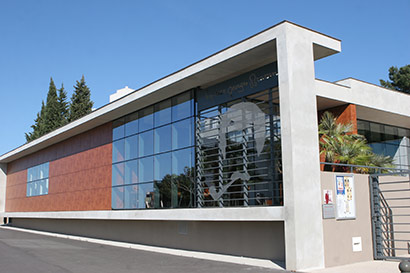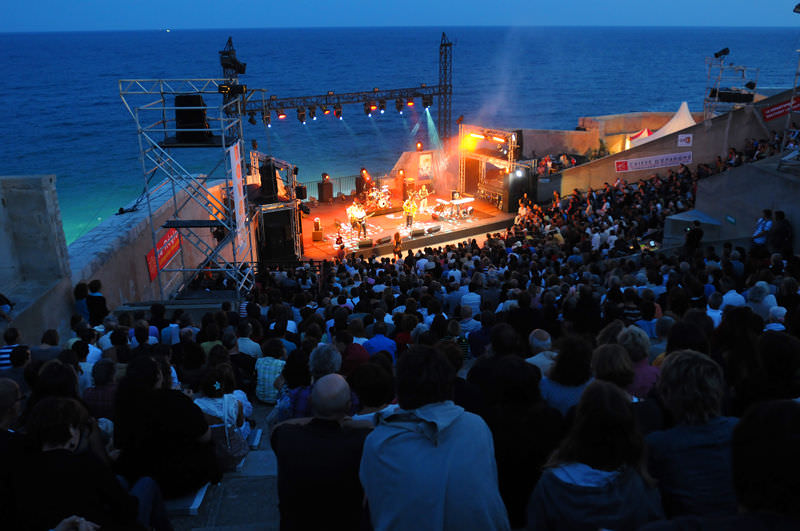Unlike its big sisters – Nimes or Narbonne, Sète doesn’t have a Roman past to brag about. In fact, this Mediterranean city is a relative youngster in historical terms. It was built three centuries ago — yesterday, by French standards. In the XVIIth century, to improve the economic situation of his kingdom, Louis XIV decided to develop the maritime trade. But, first, he needed an open port on the Mediterranean sea. His advisors recommended a spot in the southern part of France at the foot of the Mont Saint-Clair, across from the Thau Lagoon. Construction begins, and in 1666, the port of Cette – the original name – comes to life. Today, it stands as the first French Mediterranean port.
Naturally, you may think of Sète as a fishing town. Indeed, the city’s activities evolve largely around its fishing economy. But that‘s not all there is. With its 8 miles of impeccably maintained white-sand beaches, seaside restaurants and access to nautical sports, Sète fits the standards of a beach resort. Furthermore, in the last several years, the ‘Pearl of the Mediterranean’ has acquired a new reputation: that of a town friendly to art and culture. All-year around, particularly during the summer months, Sète hosts dance performances, poetry readings, jazz concerts, plays and art exhibits, often in exceptional settings.
Let’s start our cultural tour by paying respect to two of Sète’s most beloved sons: Paul Valery and George Brassens. Next, we will browse through the unusual Museum of Modest Arts before hitting the town’s hot spots.
Paul Valery Museum
One of France’s most distinguished poets, Paul Valery (1871-1945), was born in Sète. Although he eventually moved to Paris, Paul Valery remained extremely attached to his native town where he found inspiration for many of his writings. Located on the Mont Saint-Clair with a view of the sea, the Paul Valery Museum retraces the history of Sète, its people and traditions. A large hall is also dedicated to the poet. It showcases some of his early manuscripts, along with some of his drawings and watercolors. Rich of 4,000 pieces, the museum’s collection features art pieces by world-famous artists native to Sète — Robert Combas and Hervé Di Rosa. Amateurs of cubism should take note: until the end of October, visitors will be able to contemplate the works of Juan Gris. If hopping from one art exhibit to another is not your favorite thing to do, head toward the museum’s cafe. Pick a table on the outside terrace and enjoy the view on the Marine Cemetery and the Thau Lagoon. The café sits in the midst of a luxuriant garden that hosts cultural programs all-year around– literary readings, concerts, film projections and dance performances. Many events are free.
148, rue Francois Desnoyer
Espace George Brassens
Georges Brassens’ fans flock from all over the world to pay tribute to the legendary artist born in Sète in 1921. Since its opening in 1991, the Espace George Brassens has greeted 900,000 visitors. Considered one of France’s finest postwar poets, George Brassens was known for his anti-conformism and love of women. The museum traces the poet/singer/guitar player’s life through photographs, songs and videos. Furthermore, to commemorate the museum’s 20th anniversary, Sète is holding – until the end of 2011 – concerts, exhibits and lectures highlighting Brassens’ genre and influence on the international musical scene. Last word: next time you get off at the Porte des Lilas metro stop in Paris, take a close look at the mural portrait of …Brassens.You will also read a quote from his song ‘La Porte des Lilas,’ that he wrote in 1957 for the film of the same title.
67, boulevard Camille Blanc
Museum of Modest Arts (MIAM, Musée International des Arts Modestes)
Located in the heart of town, this atypical museum intends to raise everyday objects to the level of art. Funded in 2000 by Hervé Di Rosa, MIAM has become one of the region’s top attractions. The converted warehouse showcases thousand of small figurines, plastic toys, key-rings, stuffed animals and card games from all over the planet. ‘Territoires de l’Art Modeste,’ an exhibit that will close on October 2, 2011, celebrates the institution’s 10th anniversary. You will come upon a mini mechanical orchestra by Catalan composer Pascal Comelade, Robert Combas’ presentation of an original comic strip, and a selection of handkerchiefs (called ‘paños’) decorated by Chicano prisoners incarcerated in Texan prisons. A must-see for everybody in the family.
23 Quai Maréchal de Lattre de Tassigny
Sète on Stage
Not one but two! The town proudly boasts two theaters, each one set in picture-perfect decor.
Théâtre de la Mer
Can you imagine attending a literary reading or jazz concert under a star-studded sky, facing a sea punctuated by tiny lights flashing on faraway fishing boats? This is the natural decor that le Théâtre de la Mer offers to its 1400 guests. A stirring sight! Built as a fort in 1710, it was only in 1959 that the site became a theater. Although it is officially named after a well-known playwright, Sète native, Jean Vilar, the Sétois (habitants of Sète) continue to call it le Théâtre de la Mer. One of the most sought-after events, the Jazz Festival, attracts international jazz legends of the likes of Wynton Marsalis.
Promenade Marechal Leclerc
Théâtre Moliere
Already 100 years-old, the Theater Moliere is a true jewel: magnificent chandelier, red-velvet, painted ceiling… The intimate space makes it easy to immediately connect with the artists on stage. All-year long, the historical monument welcomes a variety of productions. Lyrical operas, dance performances and plays, often with an innovative twist, draw a wide public from all over the area.
Avenue Victor Hugo
Sete Events worth noting on your calendar:
Quand je pense a Fernande Festival — one week in June. The festival treats guests to a string of chansons françaises only, both oldies and new tunes.
Voix Vives de méditerranée en méditerranée — in July. The week-long event that spreads out all over town features poets from Mediterranean countries.
‘Fiest a Sète — July/August. The 3 week-long world music festival, ‘Fiest a Sète, welcomes leading artists and fresh talents. The moving fiest starts in nearby villages before making a triumphant entrance at the Theatre de la mer.
Infr’action — September. Dedicated to contemporary art, Infr’action has become one of the most important festivals on the European scene. A dozen of artists only, selected according to strict criteria, participate in the 5 day-long event. The town turns into an open stage with artists taking over the markets, docks, canals, streets and squares. The ambiance is joyful and relaxed. Events are free.
For more information, contact the Sète tourism office
Hotels in Sete
Hotel la Joie des Sables: 3 stars
Rates for double occupancy: 94 Euros and up.
Pelage de la Cornice
Hotel Imperial: 3 stars
Rates for double occupancy: 80 Euros and up.
84 Place Eduard Herriot
Written by Brigitte Aflalo-Calderon for EuropeUpClose.com







Yatra
Thursday 22nd of September 2011
Amazing france.like the pics.
Henry Williams
Wednesday 21st of September 2011
Espace George Brassens is a beautful building